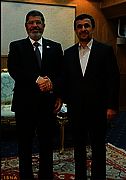Ahmadinejad Welcomed With a Shoe in Cairo
» No Khamenei Representative to See President Off at Airport
In the first visit of an Iranian president to Egypt since the 1979 Islamic revolution, Mahmoud Ahmadinejad was welcomed by the Egyptian president and a young Syrian who threw a shoe at him.
Ahmadinejad left Tehran on Tuesday morning but unlike his earlier foreign trips no representative from the supreme leader’s office went to the airport to see him off. In the past, Ali Akbar Velayati, the supreme leader’s senior advisor on international affairs or Mohammadi Golpaygani, the ayatollah’s chief of staff went to the airport to see the president off.
In recent days the head of Iran’s government has been accused of betrayal by exposing his differences with the heads of the other branches of government in the Islamic republic. Supporters of Iran’s supreme leader ayatollah Khamenei have said that the events in the Majlis have deeply hurt the leader’s feelings and offended him.
At the airport, Ahmadinejad appeared clearly grim as he criticized the arrest of his appointed head of the Social Security Organization Saeed Mortezavi and labeled the judiciary in the country to be an organization run by a special family, meaning the Larijani brothers. Ahmadinejad is in Cairo to attend the two day 12th summit of the Organization of Islamic Cooperation (OIC). Egyptian president Mohammad Morsi welcomed Ahmadinejad at the airport.
This is the first visit of an Iranian president to Egypt. Ayatollah Khomeini’s support for the assassination of Anwar Sadat, Egypt’s then president, by a militant Muslim, resulted in the break of diplomatic relations between the two countries. A street in Tehran was named after the assassin and was brought up to Ahmadinejad by reporters in a news conference in Cairo. At the airport, Ahmadinejad talked with Morsi for about 35 minutes. Morsi became president of Egypt last year after Hosni Mubarak’s twenty-year rule.
Ahmadinejad Threatens Al-Azhar Sheikh
Ahmadinejad’s entourage to Egypt includes his advisor and the current head of the Non-Aligned Movement secretariat Isfandiar Rahim Mashai, the head of the pilgrims organization Mousavi, the minister of economy Shamsedin Hosseini, the minister of intelligence Heydar Moslehi and the minister of oil Rostam Ghasemi.
Iran’s foreign minister Ali Akbar Salehi who was in Munich at the time joined the president in Cairo and immediately met with the Turkish foreign minister. He had already travelled to Cairo before. During an earlier visit by Salehi, some supporters of separatist movements in Iran’s Arab ethnic regions and Salafi personalities had held a conference in Cairo with the support of the Egyptian first vice-president, but Salehi did not take a position on this.
After meeting Morsi yesterday, Ahmadinejad visited Al-Azhar University and met its president grand sheikh Ahmed al-Tayeb. al-Azhar is recognized as the most influential Islamic center in the Sunni world.
At a news conference following this visit and after Ahmadinejad’s speech at the institution, Hassan al-Shafei a senior member of the faculty and the head of the al-Tayeb’s office spoke about the differences between the Shiite and the Sunnis. Soon after he began, Ahmadinejad who stood close to him threatened to leave the press conference if he did not stop. He repeatedly said “unity, brother” in Arabic. His threat was effective as Shafei stopped his remarks. At the end of the press conference, the two hugged each other.
Welcome with a Shoe
After this talk, Ahmadinejad went to the ancient Ras al-Hossein mosque in Cairo. Some Shiite scholars believe that imam Hossein’s head was brought to this mosque after the Kerbala battle and beheading in 680 AD. After the memorial rituals by Ahmadinejad and while he was on his way out of the mosque, a group stood outside demonstrating enthusiasm over the president’s visit. As he shook the hands of some of the supporters, someone threw a shoe at him. Egyptian press reported that the person who threw a shoe was a Syrian opponent of Bashar Assad who was arrested by Egyptian security agents.
The Islamic republic is among the staunchest supporters of Bashar Assad’s regime in Syria and has till now opposed any process to end the two-year Syrian crisis that would include the removal of Assad.
Relations between Iran and Egypt have deteriorated because of their differences over Syria’s Bashar Assad. In yesterday’s meeting, Morsi encouraged the Iranian government to change its stance on Syria.
During his visit to Iran last year to pass the leadership of the Non-Aligned Movement from Egypt to the Islamic republic, Mohammad Morsi sternly criticized Assad’s regime for its slaughter of the Syrian people and called for his removal from power.
As Iran’s national television network was broadcasting Morsi’s speech at the NAM conference in Tehran, it changed its remarks in its translation version to portray that the Egyptian president was supporting the people of Bahrain.
Egypt’s foreign minister Mohamed Kamel Amr had earlier told his Iranian counterpart Ali Akbar Salehi that “the improvement of relations between Iran and the Arab world rested on Iran’s coordination with the efforts underway to solve the Syrian crisis.”


